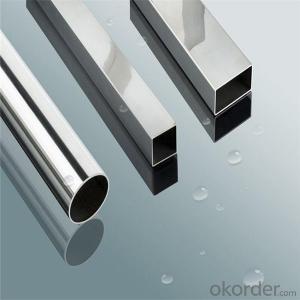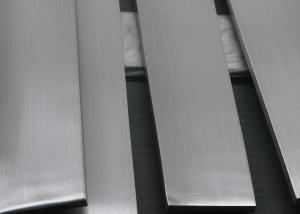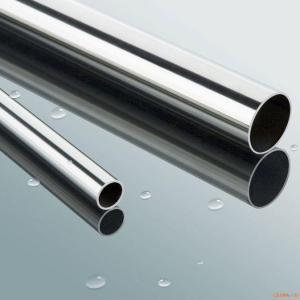Black Stainless Steel Pipes S31803
- Loading Port:
- Shanghai
- Payment Terms:
- TT OR LC
- Min Order Qty:
- -
- Supply Capability:
- 200000 kg/month
OKorder Service Pledge
OKorder Financial Service
You Might Also Like
S31803 dual phase stainless steel is composed of 21% chromium, 2.5% molybdenum and nickel nitrogen form 4.5% duplex stainless steel alloy. It has high strength, good toughness and good overall and local stress corrosion resistance. The yield strength of S31803 duplex stainless steel is two times that of austenitic stainless steel, this feature enables designers to reduce weight in the design of products, let this alloy has a price advantage than 316317L. This alloy is particularly applicable to -50 degrees F/+600 degrees F temperature range. Beyond this temperature range of applications, also can consider this kind of alloy, but there are some limitations, especially when used in welding structure.
The characteristics of S31803 duplex stainless steel:
1.S31803 dual phase stainless steel and austenitic stainless steel 316L and 317L compared, S31803 properties of dual phase steel in the resistance to pitting and crevice corrosion is more superior, it has very high corrosion resistance of austenite, and compared, its lower thermal expansion coefficient, high thermal conductivity.
2.S31803 dual phase stainless steel and austenitic stainless steel are compared, the compressive strength is two times, compared with 316L and 317L, the designer can reduce the weight. Alloy 2205 is particularly applicable to - 50 degrees F/+600 degrees F temperature range, in a strictly limited circumstances (especially for welding structure), can also be used to lower the temperature.
Chemical composition: C = 0.030, Mn = 2 Si = 1, P = 0.030 S = 0.020 Cr and 22 ~ 23 Ni and 4.5 ~ 6.5 Mo3.0 ~ 3.5 N0.14 ~ 0.20 (austenite and ferrite)
S31803 dual phase stainless steel applications:
Pressure vessels, pressure tanks, high pressure pipe, heat exchanger (chemical processing industry).
Petroleum natural gas pipeline, the heat exchanger tubes.
And the sewage treatment system.
And the pulp and paper industry classifier, bleaching equipment, storage and processing system.
High strength corrosion environment of the rotary shaft, impeller blades, press roller, etc..
Cargo tank, ship or truck
And food processing equipment
S31803 dual phase stainless steel standard:
ASTM/ASME..A240 UNS S32205/S31803...
EURONORM..1.4462 X2CrNiMoN 22.5.3...
AFNOR....Z3 CrNi 22.05 AZ
DIN....W. Nr 1.4462
S31803 dual phase stainless steel corrosion resistance:
Uniform corrosion
Because the chromium content (22%), Mo (3%) and nitrogen content (0.18%), 2205 of the properties of corrosion resistance is better than that of 316L and 317L in most environments.
Local corrosion
The content of chromium, molybdenum and nitrogen S31803 duplex stainless steel in the oxidizing and acidic solution, has a strong ability to resist corrosion and crevice corrosion.
Stress corrosion resistance
Dual phase microstructure of stainless steel is helpful to improve the resistance of the stainless steel stress corrosion cracking ability. At a certain temperature, oxygen tension exists, and the absence of chloride, austenitic stainless steel will happen to chloride stress corrosion. Because of these conditions is not easy to control, so the use of 304L, 316L and 317L are limited in this respect.
Corrosion fatigue
High strength and corrosion resistance of S31803 duplex stainless steel which has high resistance to corrosion fatigue strength. Processing equipment susceptible to corrosion environment and cyclic loading, the characteristics of S31803 duplex stainless steel is very suitable for such applications.
Structure
Chemical composition of S31803 duplex stainless steel after 1900 degrees /1922 degrees F (1040 degrees /1080 degrees C) solution annealed microstructure can obtain ideal 50 alpha / 50 gamma. If the heat treatment temperatures above 2000 degrees F, may lead to an increase in the ferrite components. Like other dual phase stainless steel, alloy 2205 is easily affected by the intermetallic phase precipitation. Intermetallic phases at 1300 DEG F and 1800 DEG between F at 1600 DEG F precipitation, temperature, the precipitation of the fastest. Therefore, we need to conduct experiments on the S31803 duplex stainless steel, to ensure that no intermetallic phase, testing, reference ASTM A 923.
S31803 dual phase stainless steel processing
Hot forming
We suggest that should be carried out in the following 600 degrees F temperature forming. In hot forming processing, the workpiece should be heated, should be in 1750 degrees F to 2250 degrees F within the temperature range of 2205 alloy under this temperature, very soft. If the temperature is too high, easy to hot tearing 2205 alloy. Below this temperature, the austenite will be broken. Below 1700 degrees F, because of the influence of temperature and deformation, intermetallic will soon form. After hot forming, should be an immediate solution annealed to at least 1900 degrees F temperature, and quenching to restore its phase equilibrium, toughness and corrosion resistance. We do not recommend eliminating stress, but if you must do so, materials to be solution annealed at a minimum of 1900 degrees F temperatures, then rapidly cooling, water quenching.
Cold forming
S31803 dual phase stainless steel can be cut and cold forming. However, due to the high strength and hardness of 2205 alloy itself, it than austenitic steel is more need for cold forming, also because of its high strength, should give full consideration to the factors of springback.
- Q:Can stainless steel pipes be insulated with polyimide?
- Indeed, polyimide is a suitable material for insulating stainless steel pipes. Its exceptional thermal stability, electrical insulation properties, and resistance to chemicals have made it highly sought-after in numerous industries. With the ability to endure high temperatures and exhibit low thermal conductivity, polyimide proves to be an optimal selection for insulating stainless steel pipes, particularly in scenarios where heat resistance and energy preservation are critical. By implementing polyimide insulation, heat transfer can be minimized, condensation can be avoided, and the overall efficiency and performance of stainless steel pipes can be enhanced.
- Q:How do stainless steel pipes compare to PVC-U pipes?
- Stainless steel pipes and PVC-U pipes are two commonly used materials for various piping applications, and they have their own unique characteristics and advantages. Firstly, stainless steel pipes are known for their exceptional durability and strength. They are highly resistant to corrosion, rust, and other chemical reactions, making them ideal for applications where the pipes come into contact with aggressive substances or are exposed to harsh environments. Stainless steel pipes can withstand high temperatures and pressures, making them suitable for demanding industrial applications. On the other hand, PVC-U (polyvinyl chloride unplasticized) pipes are lightweight and easy to install. They are cost-effective and have good chemical resistance, especially against most acids, alkalis, and salts. PVC-U pipes are commonly used in plumbing, irrigation, and drainage systems due to their excellent flow characteristics and low maintenance requirements. In terms of versatility, stainless steel pipes can be used for a wide range of applications, including water supply, gas distribution, oil and gas pipelines, and sewage systems. They are often preferred in industrial settings where reliability and longevity are crucial. PVC-U pipes, on the other hand, are more commonly used in residential and commercial settings where cost-efficiency and ease of installation are important factors. It is worth noting that stainless steel pipes are typically more expensive than PVC-U pipes, both in terms of material cost and installation. However, given their longer lifespan and superior resistance to corrosion and chemical reactions, they often prove to be a more cost-effective option in the long run. Ultimately, the choice between stainless steel pipes and PVC-U pipes depends on the specific requirements of the application. Factors such as cost, durability, resistance to corrosion, ease of installation, and maintenance should all be taken into consideration when comparing these two materials for a particular piping project.
- Q:Stainless steel why rust?
- Stainless steel surface adhesion contains acid, alkali and salt substances (such as decoration wall caustic soda, lime water splash), causing local corrosion.
- Q:Can stainless steel pipes be welded to other materials?
- Indeed, the welding of stainless steel pipes with other materials is a possibility. Nevertheless, the effectiveness and feasibility of the welding procedure may differ depending on the particular materials at hand. Prior to embarking on the welding endeavor, it is crucial to take into account factors such as the composition, thickness, and intended usage of the materials. Furthermore, it is imperative to employ appropriate welding methods and equipment to guarantee a robust and long-lasting connection between the stainless steel pipe and the alternative material.
- Q:Can stainless steel pipes be used in the construction industry?
- Indeed, the utilization of stainless steel pipes in the construction industry is feasible. Stainless steel presents numerous advantages, establishing it as a preferred option for diverse construction applications. Initially, the outstanding corrosion resistance of stainless steel pipes is indispensable in construction ventures involving exposure to moisture, chemicals, or severe weather conditions. This resistance against corrosion guarantees the pipes' longevity and durability, subsequently reducing costs associated with maintenance and replacement. Moreover, stainless steel pipes possess remarkable strength and impact resistance, rendering them appropriate for structural purposes in buildings, bridges, and other construction projects. Their strength facilitates the transportation of fluids and gases under high pressure, thus making them ideal for plumbing and HVAC systems. Furthermore, stainless steel pipes demonstrate a high level of hygienic properties and resistance to bacteria growth, which renders them appropriate for implementation in the food and beverage industry, hospitals, and laboratories. These pipes are easily maintained and cleaned, ensuring the safety and purity of the transported materials. Additionally, stainless steel pipes have an aesthetic appeal, as they can be polished to a high shine or finished in various colors, thereby making them suitable for architectural usage. They can be employed for handrails, staircases, exterior cladding, and other decorative components in buildings. In summary, stainless steel pipes are versatile, durable, and corrosion-resistant, which ultimately establishes them as an exceptional choice for the construction industry.
- Q:Can stainless steel pipes be engraved?
- Yes, stainless steel pipes can be engraved. Engraving is a process that involves etching or carving designs, patterns, or text onto the surface of an object. Stainless steel is a versatile material that can be engraved using various methods, such as laser engraving, rotary engraving, or hand engraving. Laser engraving is particularly popular for stainless steel pipes as it provides precise and permanent markings. The engraved design or text can enhance the aesthetic appeal of the pipes and also serve functional purposes, such as identification or branding. However, it is important to note that the depth and quality of the engraving may vary depending on the type and grade of stainless steel used.
- Q:What is sanitary stainless steel pipe?
- Forbidden oil degree: after the passivation is finished, the cleaning of the forbidden oil is carried out, and the oil pollution on the surface of the steel pipe is removed. After the completion, the grease analyzer is used to check the oil pollution in the pipe wall, and the fluid substance that flows in the pipe is prevented
- Q:How do stainless steel pipes compare to fiberglass-reinforced pipes?
- Stainless steel pipes and fiberglass-reinforced pipes are both popular choices for various applications, but they have distinct characteristics that set them apart. Firstly, stainless steel pipes are known for their exceptional durability and strength. They can withstand high pressure, temperature, and corrosion, making them suitable for industrial and heavy-duty applications such as oil and gas, chemical processing, and plumbing systems. Stainless steel pipes are also non-combustible and have a long lifespan, which reduces the need for frequent replacements. On the other hand, fiberglass-reinforced pipes (FRP) offer unique advantages in certain situations. Fiberglass-reinforced pipes are lightweight and have excellent resistance to chemicals, making them ideal for applications in corrosive environments like wastewater treatment plants, desalination facilities, and chemical processing plants. Additionally, FRP pipes have better insulating properties compared to stainless steel pipes, which can be beneficial when thermal insulation is required. Cost-wise, stainless steel pipes are generally more expensive than fiberglass-reinforced pipes. However, it's important to consider the specific requirements of the project and the expected lifespan of the pipes when evaluating the overall cost-effectiveness. Ultimately, the choice between stainless steel pipes and fiberglass-reinforced pipes depends on the specific needs of the application. If durability, strength, and resistance to high pressure and temperature are the primary concerns, stainless steel pipes are the preferred option. On the other hand, if weight, corrosion resistance, and insulation properties are more important, fiberglass-reinforced pipes may be the better choice.
- Q:What are the common wall thicknesses for stainless steel pipes?
- The common wall thicknesses for stainless steel pipes vary depending on the application and the specific grade of stainless steel being used. However, some commonly available wall thicknesses for stainless steel pipes include Schedule 5S, Schedule 10S, Schedule 40S, and Schedule 80S. Schedule 5S typically has a thinner wall thickness and is suitable for low-pressure and light-duty applications. Schedule 10S is slightly thicker and can withstand higher pressures, making it suitable for a wider range of applications. Schedule 40S is commonly used in industrial and commercial settings where higher pressures and temperatures are involved. Schedule 80S has the thickest wall thickness and is typically used in heavy-duty applications, such as the oil and gas industry. It is important to note that these are just some of the common wall thicknesses for stainless steel pipes, and there may be other options available depending on the specific requirements of the project. Consulting with a professional or referring to industry standards and specifications can help determine the appropriate wall thickness for a particular application.
- Q:Can stainless steel pipes be used for geothermal heating systems?
- Yes, stainless steel pipes can be used for geothermal heating systems. Stainless steel is highly resistant to corrosion, making it suitable for the harsh underground environment of geothermal systems. It also has excellent thermal conductivity, allowing for efficient heat transfer.
1. Manufacturer Overview |
|
|---|---|
| Location | |
| Year Established | |
| Annual Output Value | |
| Main Markets | |
| Company Certifications | |
2. Manufacturer Certificates |
|
|---|---|
| a) Certification Name | |
| Range | |
| Reference | |
| Validity Period | |
3. Manufacturer Capability |
|
|---|---|
| a)Trade Capacity | |
| Nearest Port | |
| Export Percentage | |
| No.of Employees in Trade Department | |
| Language Spoken: | |
| b)Factory Information | |
| Factory Size: | |
| No. of Production Lines | |
| Contract Manufacturing | |
| Product Price Range | |
Send your message to us
Black Stainless Steel Pipes S31803
- Loading Port:
- Shanghai
- Payment Terms:
- TT OR LC
- Min Order Qty:
- -
- Supply Capability:
- 200000 kg/month
Offcanvas right
OKorder Service Pledge
OKorder Financial Service
Similar products
New products
Hot products
Hot Searches
Related keywords






























